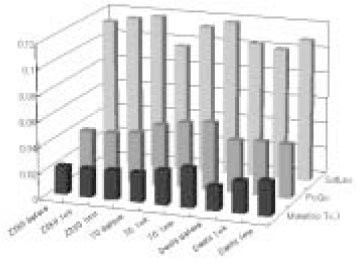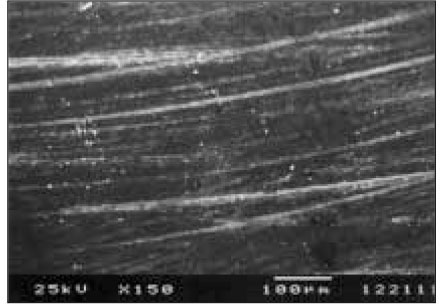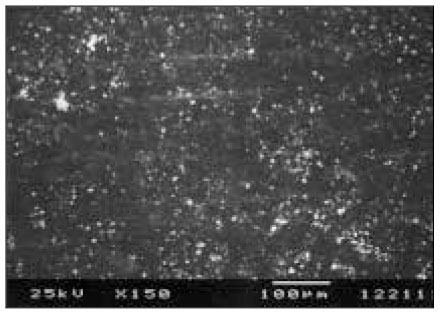Articles
- Page Path
- HOME > Restor Dent Endod > Volume 28(5); 2003 > Article
- Original Article Surface roughness of universal composites after polishing procedures
- Jae-Yong Lee, Dong-Hoon Shin
-
2003;28(5):-377.
DOI: https://doi.org/10.5395/JKACD.2003.28.5.369
Published online: September 30, 2003
Department of Conservative Dentistry, College of Dentistry, Dankook University, Korea.
- Corresponding author (donyshin@dankook.ac.kr)
Copyright © 2003 Korean Academy of Conservative Dentistry
- 870 Views
- 1 Download
- 5 Crossref
Abstract
-
The aim of this study was to evaluate the effect of two polishing methods and chemical conditioning on the surface of hybrid composites.Ninety cylindrical specimens (diameter: 8 mm, depth: 2 mm) were made with three hybrid composites - Filtek Z250, Tetric Ceram, DenFil. Specimens for each composite were randomly divided into three treatment subgroups - ① Mylar strip (no treatment), ② Sof-Lex XT system, ③ PoGo system. Average surface roughness(Ra) was taken using a surface profilometer at the time of setting and after immersion into 0.02N lactic acid for 1 week and 1 month. Representative specimens were examined by scanning electron microscopy. The data were analyzed using ANOVA and Scheffe's tests at 0.05% significance level.The results were as follows:
Mylar strip resulted in smoother surface than PoGo and Sof-Lex system(p<0.001). Sof-Lex system gave the worst results.
Tetric Ceram was smoother than DenFil and Z250 when cured under only mylar strip. However, it was significantly rougher than other materials when polished with PoGo system.
All materials showed rough surface after storage in 0.02N lactic acid, except groups polished with a PoGo system.
The PoGo system gave a superior polish than Sof-Lex system for the three composites. However, the correlation to clinical practice may be limited, since there are several processes, such as abrasive, fatigue, and corrosive mechanisms. Thus, further studies are needed for polishing technique under in vivo conditions.
- 1. Marigo L, Rizzi M, La Torre G, Rumi G. 3-D surface profile analysis: different finishing methods for resin composites. Oper Dent. 2001;26: 562-568.PubMed
- 2. Strassler HE, Baum G. Current concepts in polishing composite resins. Pract Periodontics Aesthet Dent. 1993;5: 3 Suppl 1. 12-17.PubMed
- 3. Yap AU, Lye KW, Sau CW. Surface characteristics of tooth-colored restoration polished utilizing different polishing system. Oper Dent. 1997;22(6):260-265.PubMed
- 4. Toledano M, De La Torre FJ, Osorio R. Evaluation of two polishing methods for resin composites. Am J Dent. 1994;7: 328-330.
- 5. van Noort R, Davis LG. The surface finish of composite resin restorative materials. Br Dent J. 1984;157(10):360-364.ArticlePubMedPDF
- 6. Weitman RT, Eames WB. Plaque accumulation on composite surfaces after various finishing procedures. Oral Health. 1975;65(12):29-33.Article
- 7. Bollen CM, Lambrechts P, Quirynen M. Comparison of surface roughness of oral hard materials to the threshold surface roughness for bacterial plaque retention: a review of the literature. Dent Mater. 1997;13(4):258-269.ArticlePubMed
- 8. Joniot SB, Gregoire GL, Auther AM, Roques YM. Three-dimensional optical profilometry analysis of surface states obtained after finishing sequences for three composite resins. Oper Dent. 2000;25(4):311-315.PubMed
- 9. Bouvier D, Duprez JP, Lissac M. Comparative evaluation of polishing systems on the surface of three aesthetic materials. J Oral Rehabil. 1997;24(12):888-894.ArticlePubMed
- 10. Roeder LB, Tate WH, Powers JM. Effect of finishing and polishing procedures on the surface roughness of packable composites. Oper Dent. 2000;25(6):534-543.PubMed
- 11. Kaplan BA, Goldstein GR, Vijayaraghavan TV, Nelson IK. The effect of three polishing systems on the surface roughness of four hybrid composites: a profilometric and scanning electron microscopy study. J Prosthet Dent. 1996;76(1):34-38.ArticlePubMed
- 12. Turssi CP, Saad JR, Duarte SL Jr, Rodrigues AL. Composite surfaces after finishing and polishing techniques. Am J Dent. 2000;13(3):136-138.PubMed
- 13. Lutz F, Setcos JC, Phillips RW. New finishing instruments for composite resins. J Am Dent Assoc. 1983;107(4):575-580.ArticlePubMed
- 14. Stoddard JW, Johnson GH. An evaluation of polishing agents for composite resins. J Prosthet Dent. 1991;65(4):491-495.ArticlePubMed
- 15. Chung KH. Effects of finishing and polishing procedures on the surface texture of resin composites. Dent Mater. 1994;10(5):325-330.ArticlePubMed
- 16. van Dijken JW, Ruyter IE. Surface characteristics of posterior composites after polishing and toothbrushing. Acta Odontol Scand. 1987;45(5):337-346.ArticlePubMed
- 17. Jung M. Finishing and polishing of a hybrid composite and a heat-pressed glass ceramic. Oper Dent. 2002;27(2):175-183.PubMed
- 18. Fruits TJ, Miranda FJ, Coury TL. Effects of equivalent abrasive grit sizes utilizing differing polishing motions on selected restorative materials. Quintessence Int. 1996;27(4):279-285.PubMed
- 19. Albers HF. Tooth-colored restoratives 8th. 1996;Alto Books.
- 20. Yap AU, Lye KW, Sau CW. Effect of finishing/polishing time on surface characteristics of tooth-coloured restoratives. J Oral Rehabil. 1998;25(6):456-461.PubMed
- 21. Wu W, McKinney JE. Influence of chemicals on wear of dental composites. J Dent Res. 1982;61(10):1180-1183.ArticlePubMedPDF
- 22. Roulet JF, Walti C. Influence of oral fluid on composite resin and glass ionomer cement. J Prosthet Dent. 1984;52(2):182-189.ArticlePubMed
- 23. Setcos JC, Tarim B, Suzuki S. Surface finish produced on resin composites by new systems. Quintessence Int. 1999;30(3):169-173.PubMed
- 24. Yap AU, Low JS, Ong LF. Effect of food-simulating liquids on surface characteristics of composite and polyacid-modified composite restoratives. Oper Dent. 2000;25(3):170-176.PubMed
- 25. Jefferies SR, Barkmeier WW, Gwinnett AJ. Three composite finishing systems: a multisite in vitro evaluation. J Esthet Dent. 1992;4(6):181-185.ArticlePubMed
- 26. Berastegui E, Canalda C, Brau E, Miquel C. Surface roughness of finished composite resins. J Prosthet Dent. 1992;68(5):742-749.ArticlePubMed
- 27. Strassler HE, Bauman G. Current concepts in polishing composite resins. Pract Periodontics Aesthet Dent. 1993;5: 3 Suppl 1. 12-17.PubMed
- 28. Ferracane JL, Condon JR, Mitchem JC. Evaluation of subsurface defects created during the finishing of composites. J Dent Res. 1992;71(9):1628-1632.ArticlePubMedPDF
- 29. Kao EC. Influence of food-simulating solvents on resin composites and glass-ionomer restorative cement. Dent Mater. 1989;5(3):201-208.ArticlePubMed
- 30. Soderholm KJ. Leaking of fillers in dental composites. J Dent Res. 1983;62(2):126-130.PubMed
REFERENCES

Tables & Figures
REFERENCES
Citations

- The evaluation of surface roughness and polishing time between polishing systems
Ye-Mi Kim, Su-Jung Shin, Min-Ju Song, Jeong-Won Park
Journal of Korean Academy of Conservative Dentistry.2011; 36(2): 119. CrossRef - Surface roughness of experimental composite resins using confocal laser scanning microscope
JH Bae, MA Lee, BH Cho
Journal of Korean Academy of Conservative Dentistry.2008; 33(1): 1. CrossRef - Evaluation on the abrasion resistance of a surface sealant
Soo-Mee Kim, Sae-Hee Han, Young-Gon Cho
Journal of Korean Academy of Conservative Dentistry.2007; 32(3): 180. CrossRef - Surface roughness of composite resin according to finishing methods
Jeong-Bum Min, Kong-Chul Cho, Young-Gon Cho
Journal of Korean Academy of Conservative Dentistry.2007; 32(2): 138. CrossRef - Influence of the Surface roughness on translucency and surface color of the dental composite resins
Kyu-Jeong Cho, Su-Jung Park, Hyun-Gu Cho, Dong-Jun Kim, Yun-Chan Hwang, Won-Mann Oh, In-Nam Hwang
Journal of Korean Academy of Conservative Dentistry.2006; 31(4): 312. CrossRef









Fig. 1
Fig. 2
Fig. 3
Fig. 4
Fig. 5
Fig. 6
Fig. 7
Fig. 8
Fig. 9
Composition and manufacturers of the composites evaluated
*Bis-GMA : bisphenol diglycidyl methacrylate
§UDMA : urethan dimethacrylate
†Bis-EMA : bisphenol A polyetheylene glycol diether dimethacrylate
‡TEGDMA : triethylene glycol dimethacrylate
Polishing kits tested
Surface roughness (Ra) [Mean (S.D.)] (µm)
Statistical significance when the polishing methods and materials, immersion times and materials combination were analyzed (2-way ANOVA).
*Bis-GMA : bisphenol diglycidyl methacrylate §UDMA : urethan dimethacrylate †Bis-EMA : bisphenol A polyetheylene glycol diether dimethacrylate ‡TEGDMA : triethylene glycol dimethacrylate

 KACD
KACD












 ePub Link
ePub Link Cite
Cite

